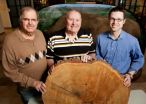(Press-News.org) CHAMPAIGN, Ill. — Researchers have constructed a 226-year history of fire in southern Illinois by looking at fire scars in tree stumps. Their study, the most in-depth fire history reported for the upper Midwest, reveals that changes in the frequency of fires dating back to the time of early European settlement permanently altered the ecology of the region.
The researchers took advantage of a 1996 timber harvest of old growth post oak trees in Hamilton County.
"I was just amazed at the fire scars in these trees," said William McClain, a botanist with the Illinois State Museum who led the study with researchers John Ebinger and Greg Spyreas, of the Illinois Natural History Survey at the University of Illinois. "I knew that the information that was in these tree trunks was really, really valuable."
McClain counted growth rings, fire scars and other distinguishing features of 36 of the old-growth post oak trees that had been cut. Luckily for the researchers, the fire-damaged trees had repeatedly healed, retaining their heartwood despite having been badly injured by numerous intense fires.
McClain is an expert in the fire history of Illinois and surrounding states, having collected and published accounts of fires from numerous historical records.
"These are written accounts of observed fires that record the date and location of each fire," he said. "And there are a significant number of Indian-started fires."
The new study, in the journal Castanea, confirms that the people who lived in Illinois before European settlers arrived were in the habit of setting fires in the region nearly every year, with fires in the Hamilton County woodland occurring at least every two or three years, McClain said. This repeated burning actually stabilized the prairies and open woodlands that dominated the region until the late 19th century, when the fire-suppression efforts of the new settlers allowed different plant species to take over, the researchers said.
The researchers found evidence of more than 100 fires in Hamilton County between the 1770s and 1996, when the trees were cut down. Prior to 1850, the woodlands burned roughly every two years. A "fire-free" interval followed between 1850 and 1885, as settlers rapidly colonized the area and suppressed fires.
Then in 1885, the fire scars appear again, probably as a result of the localized burning of woodlots, which was a tradition in the region in the late 1800s and early 1900s, the researchers said.
"These smaller, less intense fires were probably started to enhance forage quality for livestock, improve visibility for hunting and to reduce the amount of flammable material in the underbrush," Spyreas said.
But by that time the previously "open woodlands," with limited shade and even a few prairie plants growing in the understory had become a dense forest with lots of shade. The shade-intolerant post oaks could not compete with fast-growing, shade-loving species, which until 1850 had been kept in check by the frequent fires.
After the brief period of fire suppression, only established post oaks could survive as other tree species closed in around them; the shade was already too dense for post oak seedlings to survive.
"We used to call these open woodlands 'barrens,' " Ebinger said. "And they were maintained by fires coming through, maybe not every year but at least every third year. Then, 30 years after the fires stopped, the barrens didn't exist anymore."
"For hundreds, maybe thousands of years, this was a stable post oak woodland," Spyreas said. "And then you have a gap of a couple of decades where there were no fires and suddenly the whole system is completely different. It's amazing how, from Kansas to Ohio, these ecosystems completely depend on fire to be stable."
INFORMATION:
Editor's notes: To reach Greg Spyreas, call 217-819-2059; e-mail spyreas@illinois.edu.
To reach Bill McClain, call 217-854-7918; e-mail trailmarkertree@gmail.com.
The paper, "Fire History of a Post Oak (Quercus stellata Wang.) Woodland in Hamilton County, Illinois," is available online or from the U. of I. News Bureau.
Old-growth tree stumps tell the story of fire in the upper Midwest
2011-03-15
ELSE PRESS RELEASES FROM THIS DATE:
Virtual assistance is confirmed as an effective tool in monitoring HIV patients
2011-03-15
The Hospital Clínic of Barcelona presented today the results of the telemedicine program "Hospital VIHrtual", coordinated by Dr. Felipe Garcia and Dr. Agata León, from the Hospital Clínic Service of Infectious Diseases directed by Dr. Josep M ª Gatell. The tool has been created by a team from the Universidad Politécnica de Madrid, led by Prof. Enrique J. Gómez and César Cáceres. Through a direct connection via a webcam, Dr. Garcia showed a virtual consultation and explained the benefits of the project, which does not replace the classic face to face visits but complements ...
Early success of anti-HIV preventive oral drug regimen is promising, but questions remain
2011-03-15
New Rochelle, NY, March 14, 2011—The first human studies of an oral drug regimen to prevent HIV infection in high-risk individuals yielded a promising near 50% reduction in HIV incidence, but a number of issues require additional research before oral pre-exposure prophylaxis (PrEP) can be implemented on a large scale, according to an article in AIDS Patient Care and STDs, a peer-reviewed journal published by Mary Ann Liebert, Inc. (www.liebertpub.com). The article is available free online at www.liebertpub.com/apc
After the success of a trial of PrEP in a high risk population ...
Trapping a rainbow: Lehigh researchers slow broadband light waves with nanoplasmonic structures
2011-03-15
BETHLEHEM, PA—A team of electrical engineers and chemists at Lehigh University have experimentally verified the "rainbow" trapping effect, demonstrating that plasmonic structures can slow down light waves over a broad range of wavelengths.
The idea that a rainbow of broadband light could be slowed down or stopped using plasmonic structures has only recently been predicted in theoretical studies of metamaterials. The Lehigh experiment employed focused ion beams to mill a series of increasingly deeper, nanosized grooves into a thin sheet of silver. By focusing light along ...
Research shows rapid adoption of newer, more expensive prostate cancer treatments
2011-03-15
Boston, MA – With 180,000 men diagnosed with prostate cancer each year, it is one of the most common types of cancer in the country. For this reason, it has been cited as a good marker for health care spending in general, reflective of the greater trends across the United States. New research from the Dana-Farber/Brigham and Women's Cancer Center (DF/BWCC) shows that newer, more expensive treatment options for prostate cancer were adopted rapidly and widely during 2002 – 2005 without proof of their cost-effectiveness, and may offer explanations for why health care spending ...
Key mutations act cooperatively to fuel aggressive brain tumor
2011-03-15
Mutations in three pathways important for suppressing tumors cooperate to launch glioblastoma, an aggressive brain tumor that strikes children and adults. But new research from St. Jude Children's Research Hospital scientists shows those changes alone are not sufficient to cause cancer. Tumor formation requires additional mutations, some affecting different points in the same disrupted regulatory pathways.
Researchers demonstrated that in mouse models of glioblastoma, tumors develop in several regions of the brain.
The findings, as well as the technique investigators ...
Why argue? Helping students see the point
2011-03-15
Read the comments on any website and you may despair at Americans' inability to argue well. Thankfully, educators now name argumentive reasoning as one of the basics students should leave school with.
But what are these skills and how do children acquire them? Deanna Kuhn and Amanda Crowell, of Columbia University's Teachers College, have designed an innovative curriculum to foster their development and measured the results. Among their findings, published in Psychological Science, a journal of the Association for Psychological Science, dialogue is a better path to developing ...
Study puts notch on the jagged edge of lung cancer metastasis
2011-03-15
HOUSTON - Researchers discovered a new, key component in the spread of lung cancer as well as a likely way to block it with drugs now in clinical trial. The study was published today (Monday, March 14) in the Journal of Clinical Investigation.
A team led by scientists at The University of Texas MD Anderson Cancer Center found a way to identify metastasis-prone lung cancer cells and then uncovered a mechanism that shifts primary tumor cells into a more deadly type of cell with the capacity to move elsewhere in the body.
"We think tumors have to learn how to metastasize ...
DU researchers find that headway being made fighting communicable diseases globally
2011-03-15
DENVER – Those working for healthier humans around the globe are making headway in fighting communicable diseases such as AIDS, malaria and diarrheal illness, according to research from the Frederick S. Pardee Center for International Futures in the University of Denver's (DU) Josef Korbel School of International Studies.
The center recently released the third in a series of five volumes that focus on human progress in which researchers explore topics such as education, poverty, infrastructure and governance. The latest book is Improving Global Health: Forecasting the ...
Nanorods developed in UC Riverside lab could greatly improve visual display of information
2011-03-15
VIDEO:
When an external magnetic field is applied to the solution of nanorods, they align themselves parallel to one another like a set of tiny flashlights turned in one direction, and...
Click here for more information.
RIVERSIDE, Calif. – Chemists at the University of California, Riverside have developed tiny, nanoscale-size rods of iron oxide particles in the lab that respond to an external magnetic field in a way that could dramatically improve how visual information ...
NJIT prof offers new desalination process using carbon nanotubes
2011-03-15
A faster, better and cheaper desalination process enhanced by carbon nanotubes has been developed by NJIT Professor Somenath Mitra. The process creates a unique new architecture for the membrane distillation process by immobilizing carbon nanotubes in the membrane pores. Conventional approaches to desalination are thermal distillation and reverse osmosis.
"Unfortunately the current membrane distillation method is too expensive for use in countries and municipalities that need potable water," said Mitra. "Generally only industry, where waste heat is freely available, ...





